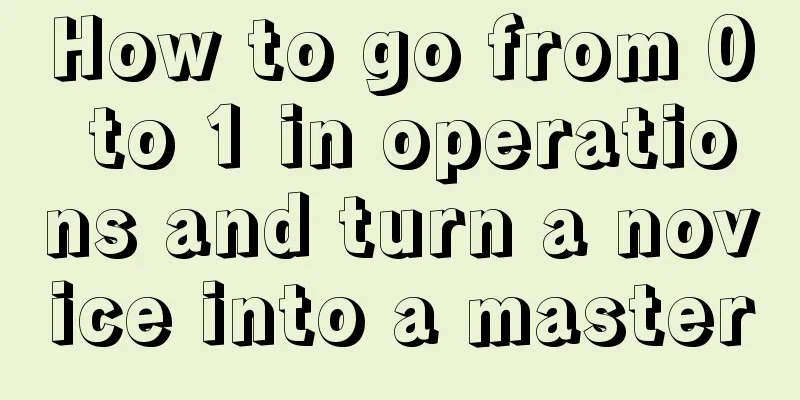How to go from 0 to 1 in operations and turn a novice into a master

|
I have read the book "Starting Operations from Scratch" by author Zhang Liang many times. No matter if I have just started or have some experience, I have different insights every time I read it again. The most important thing is to let go of your attitude, adjust your mindset, and think of yourself as a real newbie again. This is down to earth, this is easy to understand. The book has a total of nine chapters. The first two chapters are [The Concept of Operation] and [The Content of Operation]. I list them together with Chapter 7 [The Relationship between Operation and Product] as the first part as an overall grasp of operation; Chapters 3 to 5 are content operation, event operation and user operation respectively, which are listed as the second part as the main body of operation; Chapter 6 [ Data Analysis ], Chapter 8 [User Habit Development] and Chapter 9 [Mobile Operation] of this book are listed as the third part as a supplement and upgrade of operation. 1. The concept of operation: a collection of all guiding methods that can promote products, encourage user usage, and enhance user awareness. This is the author’s definition of operations. Based on this definition, we continue to break it down into four parts: promoting products, promoting user usage, improving user awareness, and gathering guiding means. Promoting products is to attract new customers, promoting user usage is to promote activation, improving user awareness is to retain customers, and the combination of guiding methods is the complementary way of attracting new customers, promoting activation and retaining customers. Two points to pay special attention to are: Is improving user awareness equivalent to retention? What does the gathering of guiding means also mean?
2. The core purpose of operation: to make the product last better and longer. The former is the data improvement of the product, and the latter is to improve the product through data analysis and user behavior research. In other words, operations must improve data and analyze data to improve operations.
3. The core tasks of operation: traffic construction + user retention. How to continuously and effectively promote user activity and retention, and discover valuable users? Both content operation and event operation can be said to belong to traffic construction, while user operation is the top priority for user retention.
4. The author suggests that the core competitiveness of operations lies in the keenness honed over a long period of time and the collection of guidance methods that are familiar to users. This core competitiveness requires training and advancement in the following five aspects: execution - communication skills - oral and written expression skills - imagination and creativity - sensitivity to data. Combining the chapter distribution of this book, we can get the following picture:
5. Relationship between operations and products: The author believes that the work of operations and product combined is the planning before 2010, and product is like giving birth to a child, while operations is responsible for raising the child. Product and operation are in a supply and demand relationship. Products are creators, and operations are managers rather than mediators. In a nutshell, the proportion of product work accounted for by products and operations changes accordingly as the product changes at different stages, but the two complement and empower each other. So how should we deal with the relationship between products in actual operations? When operations enter the product, the author provides the following methodology: A. Content Operation The author suggests that the essence of content operation is to create content that has a certain promoting effect on user stickiness and activity, covering content collection and creation, content presentation and management, content diffusion and transmission, and content effect and evaluation. This book divides content operation into six aspects: the initial stage of content operation, content operation in ongoing operation, content operation on public platforms, the core of content operation, content circulation and community operation. So, what is the core work of content operation? The author lists the following three points:
In other words, as a filler for all products, content operation must have the fundamental goal of promoting user activity and improving products. Different operation methods must be used at different stages of the product to meet user needs.
B. Event Operation Activity process: Planning—development—testing—promotion—launch—indicator monitoring—reward distribution—effect evaluation. The core of event operation: event design and cost budgeting, event risk management and emergency plans, event data monitoring and response strategies, and event effect judgment and summary. Activity design and cost budgeting, activity risk management and emergency plans belong to the work before the activity, activity data monitoring and response strategies belong to the work during the activity, and activity effect judgment and summary belong to the work after the activity. 1. Before the activity: (1) The purpose and objectives are clear. (2) Operational policy: leveraging strengths and taking advantage of opportunities. (3) Promotion of publicity channels. (4) Start from the user. * How to control operational risks and maximize user experience is an extremely important task before operations. The essence of the main risk control problems lies in the differences in understanding, information asymmetry and process gaps caused by communication problems, which can be solved by issuing detailed requirements definition documents and using process tools . What should we do specifically? a. When planning an event , consider whether there are loopholes in the event rules, whether it affects the experience of ordinary users, whether the reward settings are reasonable, how to control the operation rhythm, how to monitor the operation effect, etc. b. Organize FAQ and customer service incident templates. c. Make emergency plans. 2. When you are active: monitor activity data correctly (1) Do not monitor data that has no value, and focus on core data. (2) The essence of activity operation is to boost indicators in the short term, while data construction is long-term. 3. After the event: Activity summary report (1) Make bold assumptions and actively reproduce. (2) Cost measurement principle and KPI achievement principle. Finally, based on the summary of event operations, the author proposed that event operations should be treated with a systematic concept, that is, it is necessary to have the awareness of system reuse and periodic event planning. In fact, activity operations are mainly based on data and processes. We can summarize the pyramid capability structure that activity operations need: C. User Operation The author divides the user operation part into three small parts for detailed analysis: how to understand users, the work content of user operation, and the supplement of user operation. Let’s take a look at the first small part first. Understanding users is the premise and foundation of user operations. We can understand users through two methods: data and direct contact with users. There are five methods that you can try to directly face users: customer service event feedback, telephone follow-up, questionnaire survey, cluster survey, internal usability and ease of use testing and feedback. Next, let’s take a look at the main work content of user operations. The author proposes several principles for preventing user churn: (1)Give users everything they want (2) Continue to give them everything they want (3) Try to give them everything they might like (4) Avoid losing their interest In addition, there are two points in the book that require special attention: (1) User operations also need to change the required related data and key operational actions according to different stages. (2) Promoting user activity is basic skill. The three major principles for promoting activation are to design user behaviors that can earn rewards around the core business, emphasize the importance of continuous behavior, and try to make rewards valuable to users. Finally, let’s take a look at what other supplementary work there is to user operations. 1. User Incentives Attract users - encourage retention - avoid churn, this can be said to be the process of user operation. So what are the main means of user motivation? Titles, ranks, medals, achievements, rankings and competitions, points. Among them, the level mechanism needs to follow the following principles: sustainable growth system design; levels need to be associated with rights and value-added services. In other words, we can use the following three specific methodologies to guide the establishment of a user incentive system: (1) Designing user behaviors that can earn rewards around core business (2) Emphasize the importance of continuous behavior (3) Try to make the rewards valuable to users When designing an incentive system, we need to consider several aspects: (1) Product features (2) Operational objectives: Which user behaviors should be encouraged and which behaviors should be discouraged (3) Characteristics of customer groups (4) Cost structure 2. Respect users, but keep your distance. 3. Hierarchical management If we look at the data, user operations can probably be seen from the following three aspects: So, what should be the overall work steps of user operations? (1)Understand the user structure (2) Understand the user scale and growth or decline, and perform appropriate user segmentation. (3) Be proficient in analyzing product user behavior data (4) Propose product optimization suggestions based on user needs From my personal project experience, user operation is one of the toughest nuts to crack in product operation . It is not only reflected in the maintenance of user classification and user system, but also in correctly grasping the real needs of users. Let’s go back and look at a question in this chapter: What is the difference between acquiring new users through marketing and open source user operations? The market pays more attention to channel expansion, while open source pays more attention to channel selection. Open source obviously attaches more importance to registration conversion rate , while the market is only responsible for attracting traffic. This is my understanding. The author believes that marketing is about opening channels and bringing in users, while open source focuses more on taking over the introduced users. The four core elements of user operation are intertwined, interconnected and coherent.
User habit formation What are user habits? How to develop user habits? How to operate? This is the issue that needs to be explored in Chapter 8. The author defines "user habits" at the operational level as helping users adapt to the operational rhythm and form habits and expectations for operational activities. In other words, the formation of user habits is mainly through guiding users to educate them and improve retention rates . The author believes that the formation of user habits requires continuous and solidified operational strategies and operational rhythms, that is, there are corresponding operational strategies at each node to make users feel similar. What deserves our attention is what operations should do to cultivate user habits? Increase your operating plan from one day or one week to one month or one year. Design long-term operational strategies for key nodes. Maintain communication with product personnel and developers and make good use of resources. Make a habit of observing data. Keep an eye on competitors and make differentiated operational preparations. ii. Data Usage and Analysis 1. Channel data, cost data and revenue data are the most important operational data, but the data points of focus in each stage are different and need to be adjusted according to the different stages of the product. 2. Summary of data analysis methods: Determine the accuracy of the data, identify the factors that affect the data, attach importance to long-term data monitoring, maintain an objective perspective, and pay attention to eliminating interference items. 3. Summary of methods of using data: master historical data, summarize patterns from historical data, monitor data in reverse based on the patterns, and learn to decompose data. 4. Misconceptions in data analysis: Do not use a single type of data to evaluate the overall situation; do not exaggerate accidental events and assume that they will lead to inevitable results; avoid using conclusions to infer causes; avoid focusing solely on data. 5. Look beyond the data and pay attention to the scenarios and users behind the data: abandon your preset stance, dig deep into user behavior and system events, try to think from their perspective, and integrate key data. I have always believed that data analysis is the most core basic skill of product operation. Sensitivity to data needs to be developed through continuous project practice. ⅲ Mobile terminal operation The biggest highlight of this chapter is the analysis case of WeChat red envelopes and Alipay red envelopes . This leads to two points: simplify operations so that users can understand the content of the event. This long article summarizes and concludes the main content of the book very well. I even adjusted the reading order and sorted out the context according to my own experience and insights, but this is far from enough. When I read the chapter on user operations, I thought of another book I read recently, "Data-driven Operations on JD Platform". By comparing the various operational data, I seemed to be able to vaguely see the essence, methodology and specific work upgrade path behind the operations. In my opinion, to become a top operator, you must have the following six aspects: 1. Know how to look at data. I think this is the most basic task among all the specific work. The use of data, data analysis, and data misunderstandings can no longer fully explain the data capabilities of an operation. It should also include a big data concept. 2. Standardize operations. Whether it is a specific work process or an abstract operational process, we must have a clear understanding of it and be clear about the chain reactions that will be triggered by each step of the operation and have corresponding response measures. 3. Systematization of operations. If process-based development is only two-dimensional, then systematization is three-dimensional. At this time, operations should be transparent. 4. Operational thinking. Operations need to have the mindset of self-upgrading, which means not only knowing the level of one's own business capabilities, but also knowing what kind of macro capabilities and control are required for current operational changes. 5. Operational mentality. I have always believed that whether it is product development or operation, mentality is the foundation and the top-level design. Having a healthy and open mindset is undoubtedly helpful in becoming a top operator. 6. Ask questions. Now that we have all mastered how to find answers, we should go back and learn how to ask good questions. Mobile application product promotion service: APP promotion service Qinggua Media information flow The author of this article @豆包 Compiled and published by (APP Top Promotion), please indicate the author information and source when reprinting! |
>>: This may be the most down-to-earth and clearest way to write an operation plan!
Recommend
The latest news on the 2022 grain planting subsidy policy: How much is the grain planting subsidy per acre? Who are the recipients of the subsidy?
Starting from 2021, the central government began ...
Inventory and marketing analysis report of influencers’ advertising during Double Eleven 2020
This report mainly reviews the policies, marketin...
Short video content operation trends in 2020!
2019 can be regarded as the coldest year in the a...
Tik Tok’s monetization and commercialization trends!
For commercial products, monetization is an unavo...
0 promotion fee, UV level 100,000 To B fission review
For B-side customer acquisition, the WeChat ecosy...
MWC2017 is coming soon: Why Nokia refused to use Android
Last month's CES2017 had at least one big pie...
WeChat red envelope cover upgrade: individuals can also customize
On November 4, the WeChat red envelope cover team...
The great secret of the boat, the painting tells the story of the rudder and oars!
How did the ship appear? What did the earliest sh...
How to collect UGC content through event promotion operations?
1. How to increase the quantity and conversion ra...
Quality car purchase innovation model Autohome 11.11 "Crazy Car Purchase Festival" successfully concluded
Since the summer of this year, car sales have exp...
The official version of iOS 12 is officially announced on Apple’s official account: it will be launched at 2 a.m. tomorrow
[[243890]] After a long wait, the official versio...
If I had a hundred eyes, what would I see? - The evolution of eyes from scallops
The winning works of the 2023 "China Science...
3 rules to teach you how to seize the marketing hotspots of Dragon Boat Festival and College Entrance Examination!
Before we know it, the Dragon Boat Festival is al...
Why is it said that the Jiangcun Tomb is the Mausoleum of Emperor Wen of Han?
On the morning of the 14th, the State Administrat...
Google's self-developed Fuchsia OS will be compatible with Android: it can also run on x86 systems
[[227568]] Google has been frustrated by the disp...









